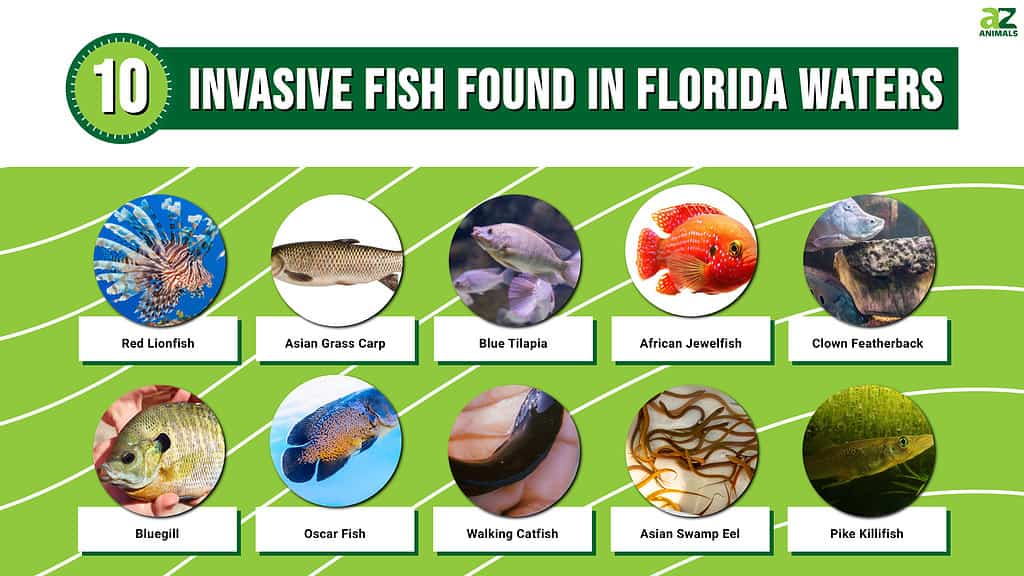
When tourists come to Florida and hit the waterways, they’re almost guaranteed to hear about the lionfish with its spines and stripes. The attractive but venomous fish is a unique catch that feels exotic when you spot them – and they are: they’re invasive.
Natively home to many unique, colorful, tropical fish, the Sunshine State has also become the breeding ground for dozens of invasive fish species. Some of them, like the lionfish, look pretty cool and all, but they’re actually quite harmful to the ecosystem. And so, many of them have no limits on them for fishers. Others, though, have some stringent guidelines placed around them.
If you’re coming to do some sport fishing, you should learn which of the invasive fish found in Florida to avoid snagging some that are protected. And know which ones you can catch a boatload of.
What Is An Invasive Fish?
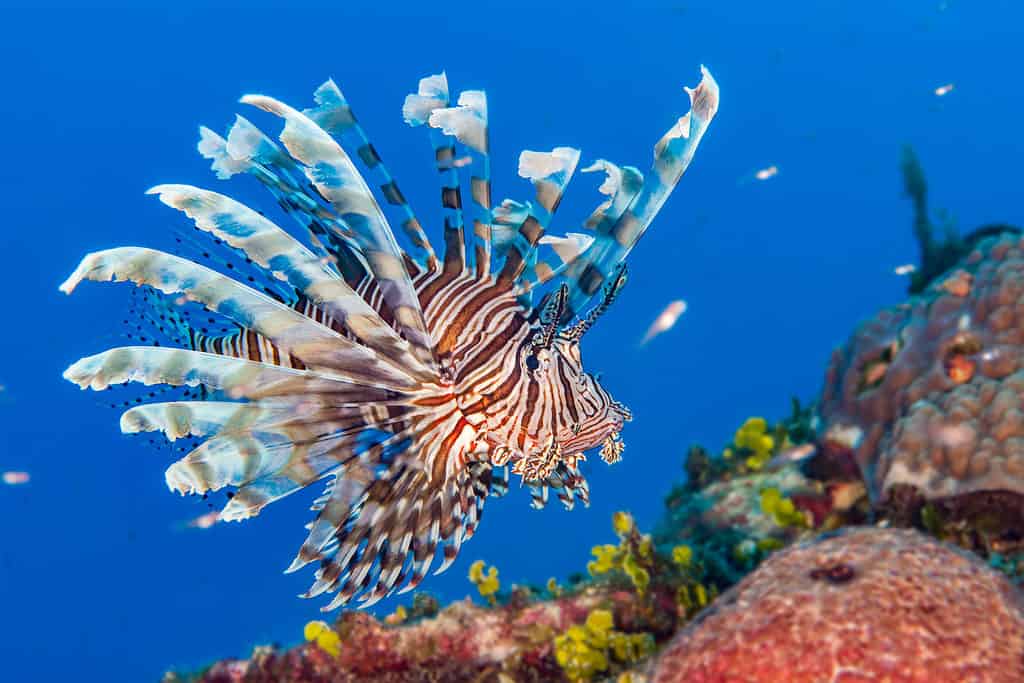
The incredibly intriguing and beautiful lionfish fin rays are venomous. The species is highly invasive in Florida.
©bearacreative/Shutterstock.com
Any fish outside its native range may be considered an invasive species. Particularly true of species that damage the local economy, public health, or environment, invasive species may even incur incentives and awards for fishers.
Where Do Invasive Fish Come From?
In most cases, exotic fish released from aquariums, by pet owners, and others are the source of invasive fish species. However, some are actually introduced into waterways to help fight other invaders and wound up making things worse.
Are All Non-Native Fish Species Invasive?
A non-native fish that is actively creating problems for the local economy, and environment, or threatening public health may be considered invasive. Other non-native species may be “just fine.” Some that have been introduced have found success in the area, such as Peacock bass from Brazil. They haven’t been particularly damaging and now are some of the most popular game fish in the state.
Rules For Catching Invasive Fish In Florida

Be sure to learn the laws and regulations around invasive fish in Florida before taking a boat out.
©iStock.com/Patrick Jennings
For most species, there is no limit to the number of invasive fish you can catch. However, some have some protections in place. Peacock bass, for example, are non-native fish but they have not been deemed invasive. These have a bag and size limit. Asian Grass carp are illegal to catch.
Before fishing in Florida, always check the current limits, rules, and regulations to ensure you don’t unintentionally break laws regarding non-native and invasive fish species.
Invasive Fish Species In Florida
With at least 40 species of invasive fish found in Florida waters, there are many to choose from when you prepare to go fishing. Check up on the rules and regulations surrounding your particular species of interest and then gear up. You’ve got plenty of catching to do!
Red Lionfish (Pterois volitans)

Lionfish has become such a pervasive species that fishermen are encouraged to catch it.
©bearacreative/Shutterstock.com
Perhaps the most well-known invasive species among non-fishing tourists is the red lionfish. The fish has become so pervasive that dining on the spiny fish has become a sought-after activity for tourists throughout the southern end of the state and the Keys. You’ll find offerings on many restaurant menus, of course, and fishers interested are highly encouraged to catch the venomous fish. When properly prepared, they’re safe to eat – but watch out for those spines! The quill-like spikes poking up are filled with venom that is quite painful (but almost never fatal). The spines, when safely removed, do not impact the safety of the fish. You can safely enjoy the fish meat which has been described as tasting a bit like lobster or shrimp.
Asian Grass Carp (Ctenopharyngodon idella)
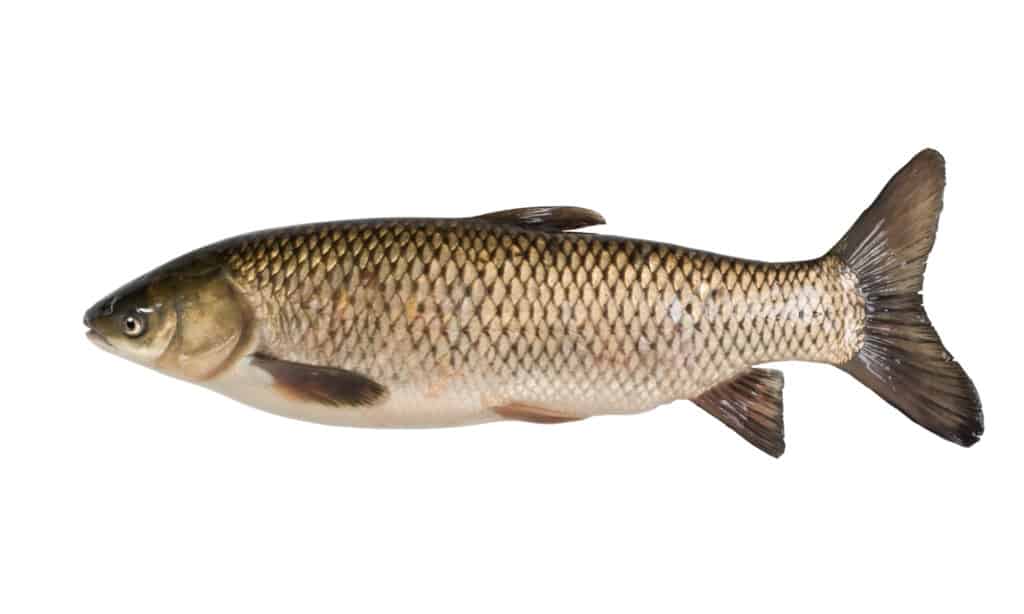
Grass carp look pretty ordinary but they have become highly invasive fish in Florida.
©Oleg_Z/Shutterstock.com
Grass carp, or Asian grass carp, natively come from the Pacific Far East ranging from northern Vietnam to Amur River along the Sino-Russian border (Chinese/Russian). The fish belongs to the Cyprinidae family and is the only species in the Ctenopharyngodon genus. Thriving in turbid rivers and floodplains and wetlands, these fish have a huge temperature range tolerance and hardiness which has allowed them to become invasive in the Floridian waters. They were originally introduced to US waters to control aquatic weeds, but that backfired, and they’ve become invasive. Still, laws state that if a grass carp is caught, it must be released unharmed.
Blue Tilapia (Oreochromis aureus)
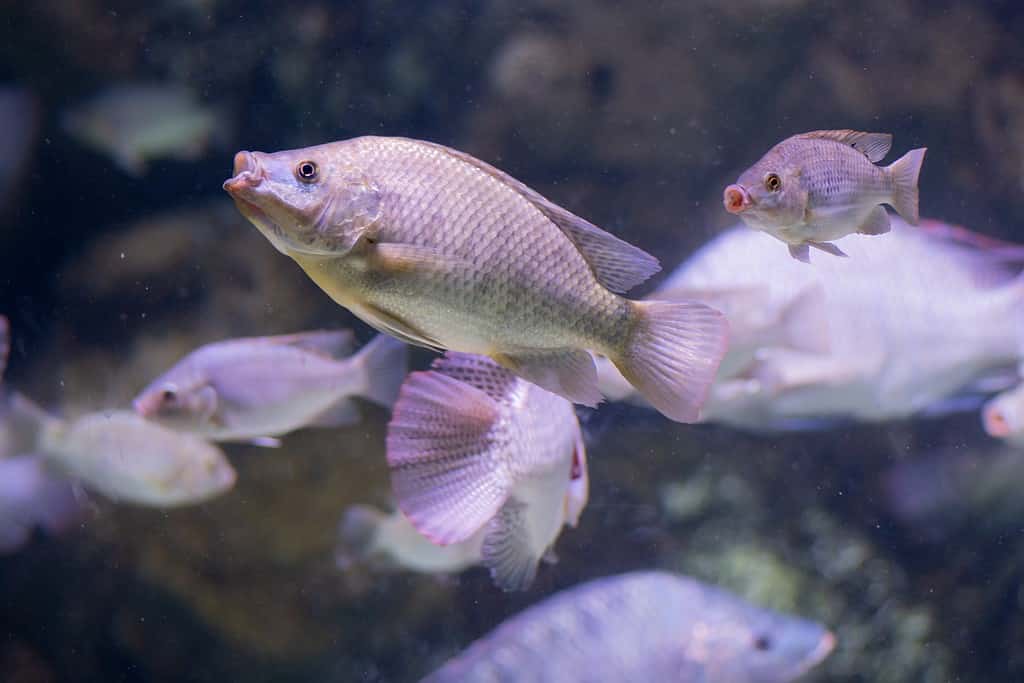
Blue tilapia are a tasty invasive species of fish in Florida.
©SingerGM/Shutterstock.com
Like grass carp, blue tilapia were released into American waters in an attempt at aquatic plant control. The species of tilapia is considered invasive in multiple locations, including both Florida and Texas. Blue tilapia also has a wide tolerance for a range of temperatures, making them hardy and difficult to handle. They compete with native species for spawning areas, food, and space.
Fish communities have been impacted by the invasive species, resulting in a threat to genetic diversity among fish because they hybridize with others within their genus. With white, flaky meat and a mild flavor, blue tilapia make excellent food for humans, so go fishing and eat up!
African Jewelfish (Hemichromis letourneuxi)
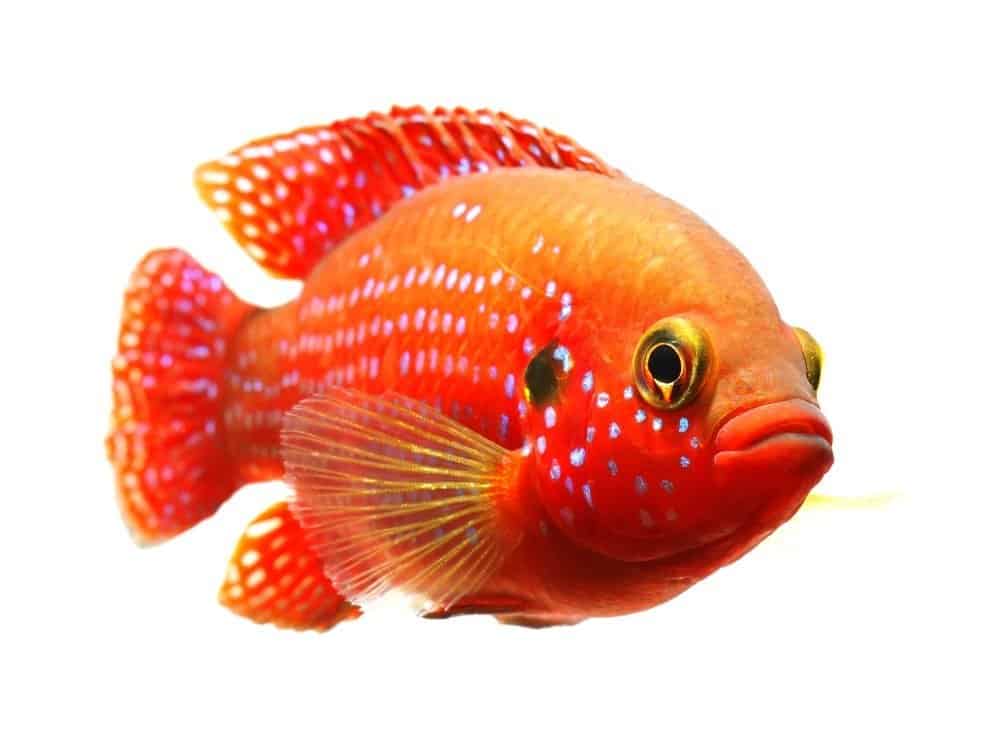
Cichlid – The African jewelfish (Hemichromis bimaculatus) is an attractive fish favored in the fish aquarium industry. They’re also, unfortunately, a highly invasive species when released in the wild.
©Grigorev Mikhail/Shutterstock.com
Native to West Africa, the African jewelfish became a popular aquarium hobby fish for Americans and others. The vibrant coloration probably largely made this so, but they’re also fairly easy to care for. While this is great for aquarists, this ease of care also means the species of cichlid tends to easily spread and become invasive – which they have. The species was introduced into the Caribbean and into the southeastern United States. The small fish are attractive but not particularly edible due to their size.
Clown Featherback (Chitala ornata)
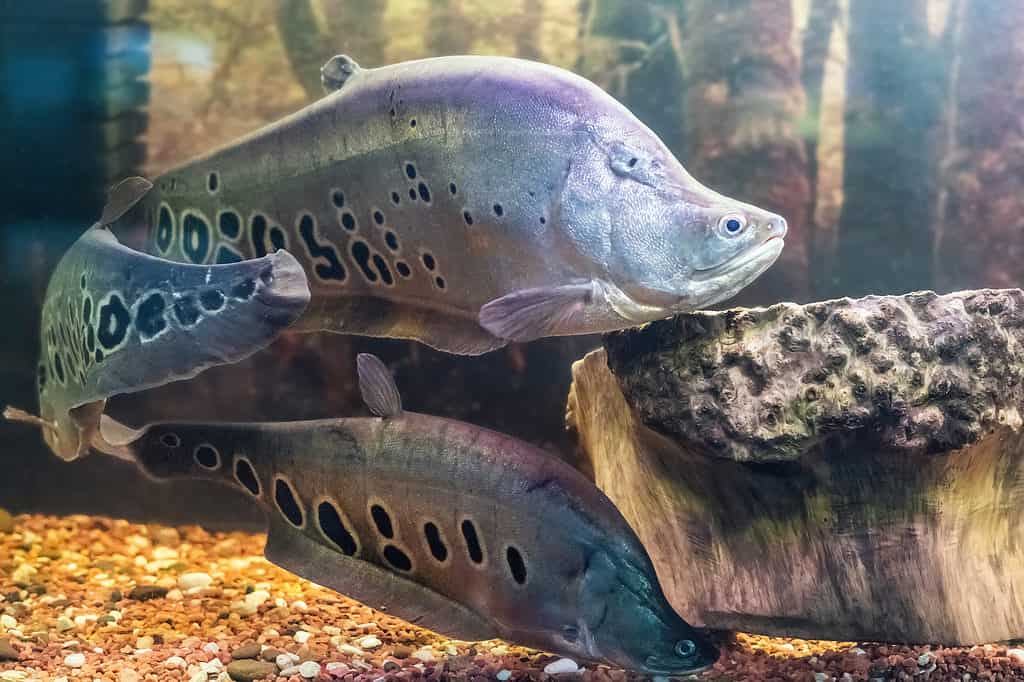
The clown featherback, clown knifefish, or spotted knifefish, Chitala ornata, is a nocturnal tropical fish that is native to freshwater habitats in Laos, Thailand, Cambodia, and Vietnam.
©iStock.com/Andrei310
Known as the clown featherback, spotted knifefish, or clown knifefish, the Chitala ornate has a knife-like body with a bulging blade. The fish is nocturnal, native to freshwater habitats in Cambodia, Laos, Vietnam, and Thailand. The tropical fish was introduced to the USA in the wild, though it is frequently seen in the aquarium trade and hobbyist culture. The fish is quite large, growing up to 3.3 feet long, generally meaning folks overcommit to the fish and sometimes wind up releasing them into the wild when they outgrow their aquariums. This may well be part of how they became invasive in Florida waters. Considered one of the most invasive fish species in the world, the clown featherback is known for hunting live prey of practically any fish that fits in their mouths.
They school together, as well, which makes them a threat to smaller fish particularly. They also breathe air to survive in stagnant waters with little oxygen, making them exceptionally hardy fish in otherwise challenging conditions.
Bluegill (Lepomis macrochirus)
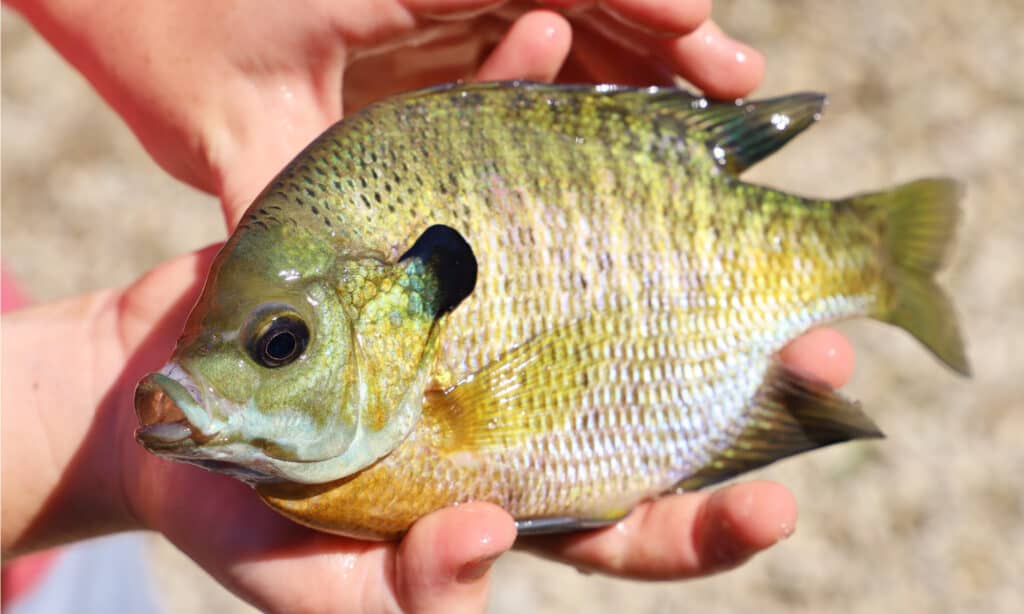
With vivid colors, bluegill is common throughout the USA. It’s a sport fish in Florida.
©Stacey Ann Alberts/Shutterstock.com
Also known as bream, brim, perch, sunperch, or sunfish, the bluegill is a popular sport fish in Florida. However, it’s not native to the area and has become invasive. The name, from the Greek, means “scaled gill cover” (Lepomis) and “large hand” (macrochirus) because of its shape and size. Other sunfish exist, as well, by different scientific names; the way to distinguish bluegill is by the dark spot on the base of the dorsal fin, a small mouth, and vertical stripes on their sides. With an average of 10 spines on the spiny dorsal fin, these fish also come with backs and upper sides in dark olive green, with blended brown, copper, orange, or even lavender on the sides, along with reddish-orange of yellow bellies. Breeding males have more intense coloring and may even be almost red.
Prolific breeders, they have often been stocked into private or public ponds for fishing purposes. They’ve managed to spread, though, and become prolific and therefore invasive. They’re now pretty much everywhere in the United States and northern Mexico and Canada.
Oscar Fish (Astronotus ocellatus)
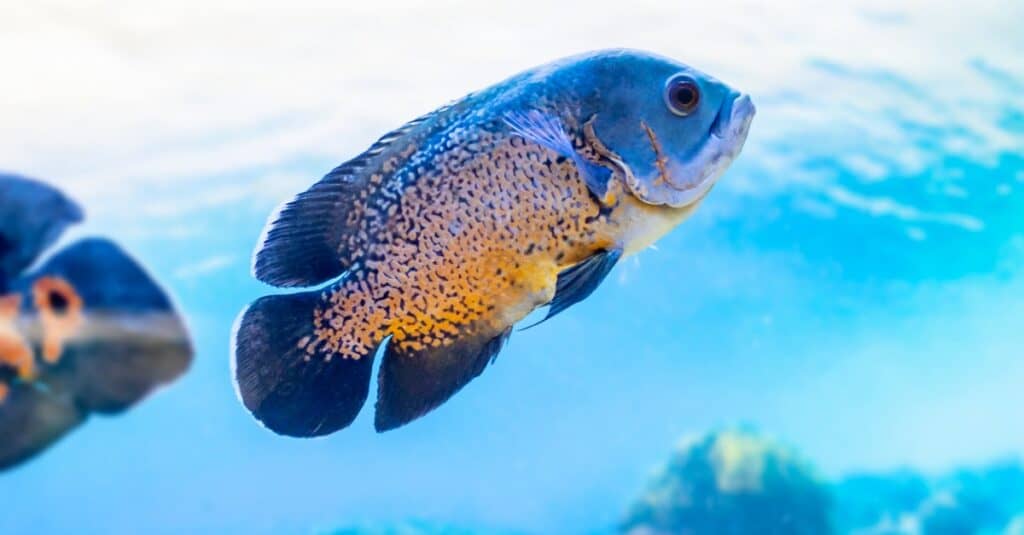
The
Oscar fish
is a bottom feeder and is known as an invasive species in Florida because of taking away from native species.
©iStock.com/Andrei310
Part of the cichlid family, and extremely popular in the aquarist hobby, Oscars come from tropical South America. Also be known as tiger Oscar, velvet cichlid, or marble cichlid, they are frequently seen in the hobbyist industry by many names. In their native region, the Oscar fish is a popular food source – in China, America, Europe, India, and Australia, you’ll find them in pet stores or fish markets. They’re more commonly found in pet stores in the US or Europe, though. The assumption is that they were released into Florida’s waterways by folks looking to free their pets.
Interestingly, the first scientific description of them in 1831 made the assumption that they are marine (ocean or saltwater) fish and categorized them improperly. The Oscar fish usually grows to up to 18 inches in length and up to 3.5 pounds in weight. The wild versions of the fish are usually dark with yellow-ringed spots, though they are known to change their coloration for territorial and combat behaviors. Juveniles look different with spotted heads and white and orange wavy bands.
Walking Catfish (Clarias batrachus)
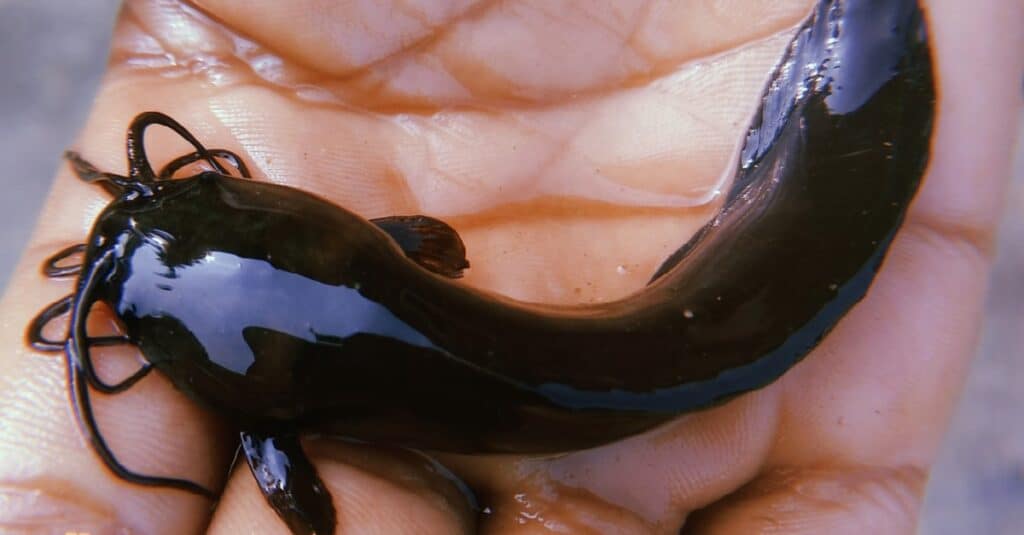
The walking catfish is a species of freshwater airbreathing catfish in Jharkhand (India). They were brought to America where they’ve become invasive in Florida.
©bajaphotos/Shutterstock.com
You may have heard of these unique fish on some kind of “strange animals” program. Walking catfish earn their name. They are fish, truly, and belong in freshwater bodies, native to Southeast Asia. However, they are able to breathe air (not just oxygen in the water). And they “walk” across dry land to find food or a better habitat. They don’t walk like animals or humans. Instead, they wiggle their way across the land using their pectoral fins to keep themselves upright. The wiggling motion is a bit like that of a snake as it crosses land. Walking catfish live in slow-moving and stagnant bodies of water. Think ponds, swamps, streams, flooded rice paddies, or temporary pools that sometimes dry up. Then, when pools dry up, or the fish are left stranded after flooding recedes, they wiggle their way along to the next habitat.
There are similar fish native to North America. But the walking catfish from Asia lacks the adipose fin of the North American species. They have elongated bodies and may grow to as long as 1.6 feet in length, weighing up to 2.6 pounds. They often have small white spots on their mainly dark gray or grayish-brown bodies. If you catch the fish while you’re out on the waterways, beware of their defenses. An embedded stinger or thorn-like barb lies hidden in their fins. Painful pricks of the barbs may lead to infection if you’re stuck by one of them.
These unusual fish are considered invasive because they consume the food supply of native fish and eat their young. They also destroy fish farms in Florida.
Asian Swamp Eel (Monopterus albus)
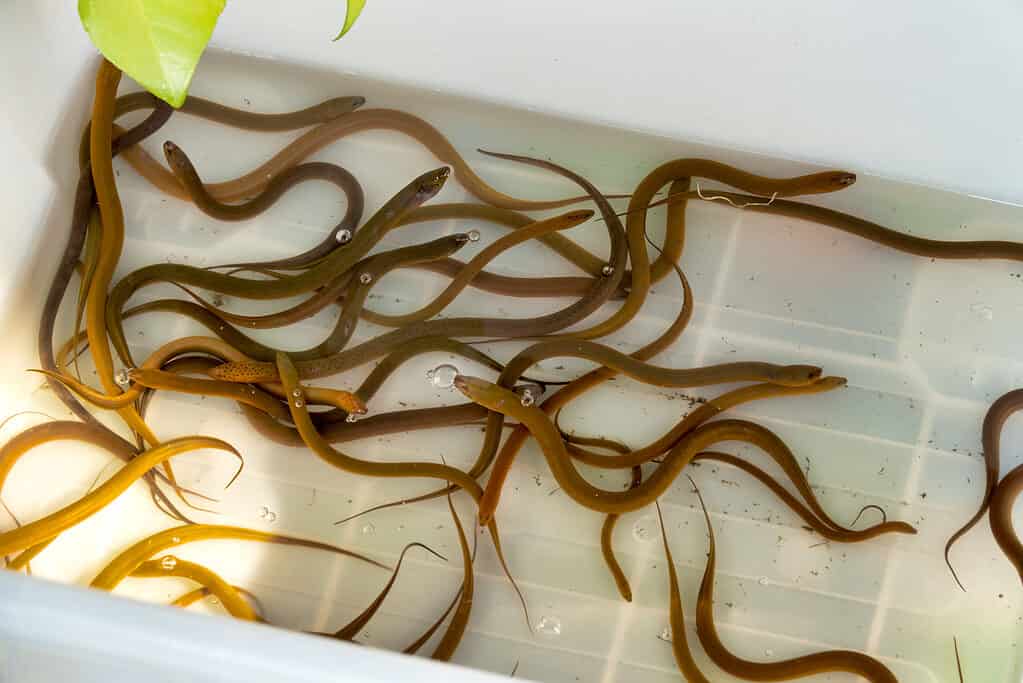
Asian swamp eels are native to southeast Asia but have been introduced into Florida and Georgia in the United States.
©iStock.com/only_fabrizio
Known as the rice eel, ricefield eel, rice paddy eel, or the Asian swamp eel, the Monopterus albus is a commercially important fish species in Asia. They’re frequently used in cooking there, as well as throughout other regions where eel is a favored seafood dish. The Asian swamp eel has been introduced in two areas in the US: near Atlanta and in the Everglades of Florida. A freshwater fish, the Asian swamp eel is technically a fish, not an eel, and is scaleless.
They have tapering tails and blunt snouts, no pectoral or pelvic fins, and only rudimentary dorsal, caudal, and anal fins. Their gill membranes are fused but have a V-shaped gill under their heads, preventing reverse flow. They tend to be olive green or brown, with dark flecks. In Florida waterways, most of them have dark bodies and heads, with dark olive or brown dorsal coloring and orange ventral coloring.
The belief is that these have been released primarily from the aquarium trade because of the coloration – favored among pet breeders rather than culinary breeders. The fish have large mouths and tiny teeth all along their upper and lower jaws. They eat worms, crustaceans, fish, and other small aquatic animals, taking away from native species. If you’re hunting Asian swamp eel, look for them in muddy, shallow, freshwater wetlands. You’ll find them in ditches, ponds, marshes, streams, canals, lakes, rivers, and reservoirs shallower than 10 feet.
Pike Killifish (Belonesox belizanus)
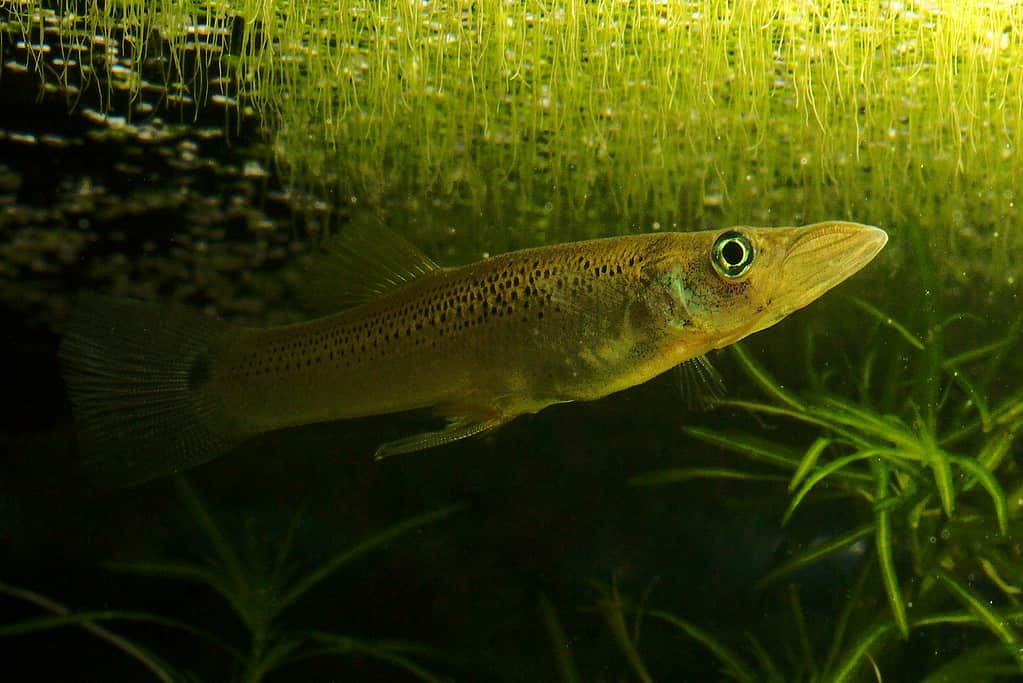
The pike killifish is small and often used in the aquarium fish trade.
©Dan Olsen/Shutterstock.com
Sometimes known as the pike topminnow or the pike killifish, the Beloneseoc belizanus comes natively from Mexico and Nicaragua. Introduced to Florida, for unknown reasons (presumed by pet owners releasing them into the wild), the fish has become invasive in the waterways. Sometimes thought of as “harmless” by the inexperienced, the fish is small and looks innocuous. Often going unnoticed in the wild, they’re actually highly specialized predators. They have exceptionally flexible upper jaws that allow them to take unusually large prey for their body size.
They usually range in size between just 3.8 inches and 7.9 inches, with a flat back profile, a jutting lower lip and large eyes. A dorsal fin set far back on the body, is usually olive green to light brown, with iridescence and small spots on the flanks. A yellowish-white belly and dark spot at the base of the caudal fin also help to make these live-bearing fish identifiable.
Summary Of 10 Invasive Fish Found In Florida Waters
| Rank | Invasive Fish |
|---|---|
| 1 | Red Lionfish |
| 2 | Asian Grass Carp |
| 3 | Blue Tilapia |
| 4 | African Jewelfish |
| 5 | Clown Featherback |
| 6 | Bluegill |
| 7 | Oscar Fish |
| 8 | Walking Catfish |
| 9 | Asian Swamp Eel |
| 10 | Pike Killifish |
The photo featured at the top of this post is © Greens and Blues/Shutterstock.com
Thank you for reading! Have some feedback for us? Contact the AZ Animals editorial team.






